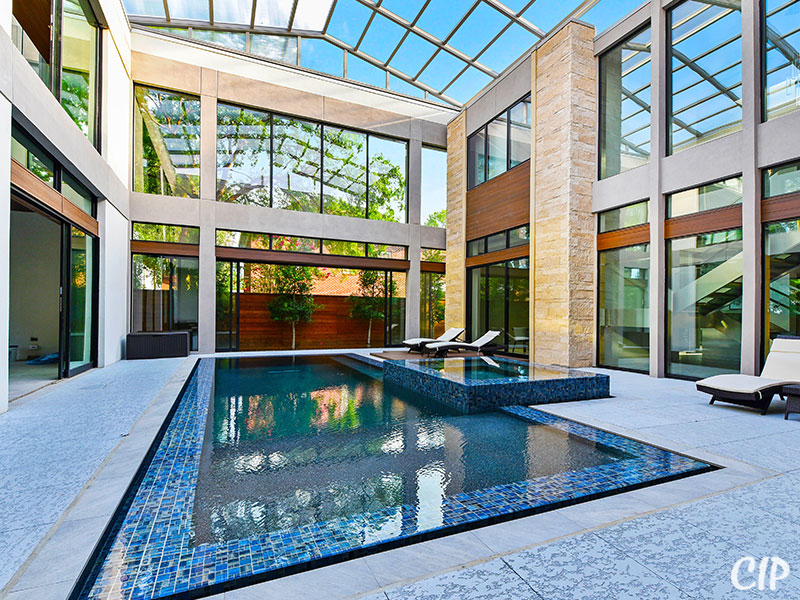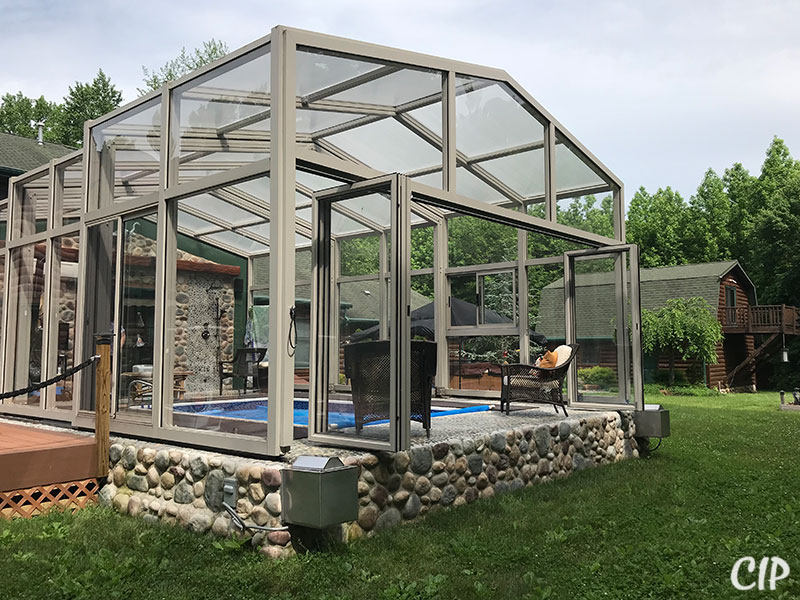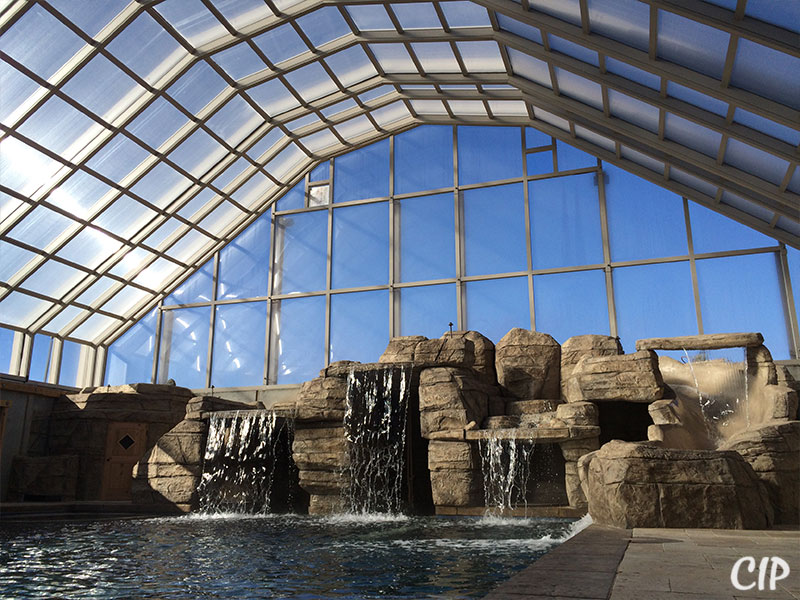When it comes to choosing an inground swimming pool, two popular options stand out: fiberglass pools and concrete pools. Each type has its unique benefits and drawbacks, making the decision a crucial one for potential pool owners. This article will explore the key differences between fiberglass and concrete pools to help you determine which option is best for your backyard oasis.
Overview of Fiberglass and Concrete Pools
Fiberglass Pools
Fiberglass pools are pre-manufactured and delivered as a single piece, making installation relatively quick and straightforward. They come in various shapes and sizes, offering a wide range of design options. The smooth, non-porous surface of fiberglass pools makes them resistant to algae growth and easy to clean. Additionally, the gel coat finish of fiberglass pools helps maintain water temperature, making it comfortable for swimming.
Concrete Pools
Concrete pools, often referred to as gunite pools, are constructed on-site using a rebar framework and a mixture of concrete. This process allows for almost limitless customization in terms of shape, size, and features. While they can take longer to install than fiberglass pools, concrete pools are known for their durability and ability to withstand extreme weather conditions. Additionally, concrete pools can be finished with a variety of materials, including tiles and plaster, allowing for a unique aesthetic.

Key Differences Between Fiberglass and Concrete Pools
- Installation Time
– Fiberglass Pools: Typically takes 1 to 3 weeks for installation. Since they are prefabricated, the process involves excavation, setting the pool, and connecting the plumbing. This quick turnaround allows homeowners to start enjoying their pool sooner.
– Concrete Pools: Usually takes 3 to 6 months to complete. The installation process includes excavation, building the framework, applying concrete, and allowing time for curing. The extensive construction timeline can be a significant factor for homeowners eager to have a pool ready for the swimming season.
- Cost
– Fiberglass Pools: Generally has a lower initial cost, with prices ranging from $25,000 to $65,000 depending on the size and features. This lower upfront investment makes fiberglass pools an attractive option for budget-conscious homeowners.
– Concrete Pools: Tends to be more expensive, ranging from $50,000 to $100,000 or more. The cost can increase significantly based on customization and additional features. While concrete pools may require a higher initial investment, many homeowners consider them a long-term investment due to their durability.
- Pool Maintenance
– Fiberglass Pools: Requires less maintenance due to their smooth surface, which resists algae and requires fewer chemicals. Regular cleaning and occasional water level adjustments are typically all that’s needed. This ease of maintenance can save homeowners both time and money in the long run.
– Concrete Pools: Requires more maintenance, as their porous surface can harbor algae and requires regular scrubbing and more frequent chemical balancing. Homeowners should also be prepared for occasional resurfacing, which can add to long-term maintenance costs.
- Durability and Lifespan
– Fiberglass Pools: While fiberglass pools are durable and can last 25 to 30 years with proper care, they can be susceptible to damage from heavy impacts. For example, dropping heavy objects into the pool may cause cracks or chips in the fiberglass surface.
– Concrete Pools: Known for their strength and longevity, concrete pools can last 50 years or more if properly maintained. However, they are prone to cracking over time, especially in areas with shifting soil. Homeowners should be aware that regular inspections and repairs may be necessary to keep a concrete pool in top condition.
- Customization
– Fiberglass Pools: Limited customization options, as they come in pre-designed shapes and sizes. While there are various models available, changes to shape or size are not possible after manufacturing. However, fiberglass pools can still be enhanced with features like lighting, water features, and decking options.
– Concrete Pools: Offers the most flexibility in terms of design. You can create any shape or size to fit your backyard, as well as incorporate features like waterfalls, benches, and unique tiling. This level of pool customization allows homeowners to create a one-of-a-kind pool that complements their outdoor space.
- Aesthetic Appeal
– Fiberglass Pools: Typically features a smooth, glossy finish that can mimic the look of tile or stone. Available in various colors and patterns, they offer an attractive appearance with less upkeep. Many homeowners appreciate the modern look of fiberglass pools and their ability to blend seamlessly into landscaped environments.
– Concrete Pools: Allows for extensive design options, including custom tiles, textures, and finishes. This versatility can create a highly personalized look that suits your style. Homeowners often use decorative concrete techniques to achieve stunning visual effects, such as stamped patterns or colored finishes.
Additional Considerations
- Climate and Location
– Fiberglass Pools: Generally performs well in a variety of climates but may not be ideal for extreme cold or very hot conditions without proper precautions. In freezing climates, homeowners should ensure that their pool is properly winterized to prevent damage.
– Concrete Pools: Offers excellent durability in extreme weather conditions, making it suitable for a wide range of climates. Concrete pools can be designed to withstand harsh winters and intense heat, giving them an edge in terms of resilience.
- Resale Value
– Fiberglass Pools: While fiberglass pools can be appealing to potential buyers due to their low maintenance, they may not always have the same perceived value as concrete pools. However, they are gaining popularity and can be a selling point in certain markets.
– Concrete Pools: Often considered a premium option, concrete pools can add significant value to a home. Their customizability and durability make them attractive to prospective buyers, which may yield a better return on investment.
- Environmental Impact
– Fiberglass Pools: Typically requires less water to fill and maintain than concrete pools. Their smooth surfaces often lead to reduced chemical usage, benefiting the environment.
– Concrete Pools: The construction process may have a larger environmental footprint due to the materials and resources required. However, once installed, concrete pools can be designed for energy efficiency, including features like variable-speed pumps and energy-efficient heaters.
- Safety Features
– Fiberglass Pools: The smooth surface of fiberglass pools is less likely to cause injuries compared to rough concrete surfaces. Additionally, many fiberglass pool manufacturers incorporate safety features, such as built-in steps and ledges, to enhance safety for children and pets.
– Concrete Pools: Homeowners can easily add safety features like pool fencing, alarms, and covers to concrete pools. The customizable nature of concrete pools allows for the integration of safety measures that meet local regulations and personal preferences.
- Temperature Control
– Fiberglass Pools: The smooth gel coat finish of fiberglass pools helps maintain water temperature, keeping the pool warmer and reducing heating costs. This is especially beneficial for families who want to enjoy their pool throughout the swimming season.
– Concrete Pools: While concrete pools may not retain heat as effectively as fiberglass pools, they can be equipped with energy-efficient heating systems to control water temperature. This means homeowners can still enjoy comfortable swimming conditions, but it may come at an additional cost.
- Warranty and Lifespan
– Fiberglass Pools: Manufacturers typically offer warranties ranging from 25 to 35 years, reflecting the durability of the materials used. This long warranty period can provide peace of mind for homeowners.
– Concrete Pools: While concrete pools can last a lifetime with proper maintenance, warranties are often shorter and may cover structural issues rather than surface wear. Homeowners should be prepared for potential repairs and resurfacing over the years.

Choosing between fiberglass and concrete pools ultimately depends on your budget, maintenance preferences, design needs, and how quickly you want your pool installed.
– Choose a fiberglass pool if you’re looking for a quicker installation, lower maintenance, and a more budget-friendly option. This is particularly appealing for families who want to enjoy their pool with minimal hassle.
– Opt for a concrete pool if you desire complete customization, plan to incorporate unique features, and don’t mind spending more time and effort on maintenance. Concrete pools are ideal for those who prioritize durability and long-term value.
Both fiberglass pools and concrete pools offer unique benefits, and the right choice will depend on your lifestyle and personal preferences. Consider your long-term goals and consult with a pool professional to help you make an informed decision that will bring enjoyment for years to come.
Ultimately, whether you choose fiberglass or concrete, investing in a swimming pool can enhance your outdoor living space and create a perfect spot for relaxation, exercise, and family fun. The decision between fiberglass pools and concrete pools can shape your summer experiences for many years, so choose wisely and enjoy your new backyard oasis!













